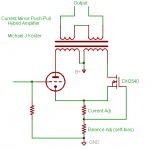The prototype from #26 is playing😎 ! Some kind of motorboating though, according to a phone call from my friend hoktuna😕. Will look deeper into it this weekend
After adjusting the ground-connections one channel of hoktunas proto is now playing:
http://www.diyaudio.com/forums/showthread.php?postid=1619528#post1619528
http://www.diyaudio.com/forums/showthread.php?postid=1619528#post1619528
The SC-OPT – self compensating, for Single Ended amplifiers:
http://www.polisois-audio.com/documenti/9th_ETF_guido.pdf
http://www.polisois-audio.com/documenti/9th_ETF_guido.pdf
re Zibi
Sorry to be the pessimist here, but the SC-OPT scheme is not really working.
The capacitor shunted tertiary winding is effectively a shorted turn, so no AC flux can pass thru it. So the AC flux has to jump from the main core to the flux escape core by traversing the laminations at a right angle to the laminating. This means there is no effective lamination at the jump area, effectively the steel itself acts as a shorted turn then. Eddy currents will short out the AC.
The flux jump problem can be fixed by putting the flux escape core thru the primary/secondary core instead. But notice that the flux escape core has the same DC issue as a normal SE xfmr core. Nothing is gained. (The main core, which is DC compensated, does nothing here for AC, since it has the tertiary shorted turn on it. Ie, it is just wasting steel. The flux escape core is exactly the same as the old gapped SE core.)
The second scheme: SC-SCC-OPT is equivalent to the old P-P + SE on the same E core idea, its just a re-drawing of the magnetic core configuration. It's easier to just use the traditional E core with a gapped center leg approach as far as sourcing iron (P-P windings around the outer E fingers, SE winding around the center E finger. Or for two P-P, each P-P winding has some turns on the outer legs and some turns on the center leg. Ie, the stereo difference travels the gap, the stereo common mode travels the outer rim with no gap)
There was a working all magnetics solution to the SE DC air gap problem on a thread here some years ago. Involved co-laminating a thin permanent magnet material along with normal "soft" magnetic material into a toroid core. Then using a DC pulse at power on to set the permanent magnet level to counter the DC steady current during operation.
Don
Sorry to be the pessimist here, but the SC-OPT scheme is not really working.
The capacitor shunted tertiary winding is effectively a shorted turn, so no AC flux can pass thru it. So the AC flux has to jump from the main core to the flux escape core by traversing the laminations at a right angle to the laminating. This means there is no effective lamination at the jump area, effectively the steel itself acts as a shorted turn then. Eddy currents will short out the AC.
The flux jump problem can be fixed by putting the flux escape core thru the primary/secondary core instead. But notice that the flux escape core has the same DC issue as a normal SE xfmr core. Nothing is gained. (The main core, which is DC compensated, does nothing here for AC, since it has the tertiary shorted turn on it. Ie, it is just wasting steel. The flux escape core is exactly the same as the old gapped SE core.)
The second scheme: SC-SCC-OPT is equivalent to the old P-P + SE on the same E core idea, its just a re-drawing of the magnetic core configuration. It's easier to just use the traditional E core with a gapped center leg approach as far as sourcing iron (P-P windings around the outer E fingers, SE winding around the center E finger. Or for two P-P, each P-P winding has some turns on the outer legs and some turns on the center leg. Ie, the stereo difference travels the gap, the stereo common mode travels the outer rim with no gap)
There was a working all magnetics solution to the SE DC air gap problem on a thread here some years ago. Involved co-laminating a thin permanent magnet material along with normal "soft" magnetic material into a toroid core. Then using a DC pulse at power on to set the permanent magnet level to counter the DC steady current during operation.
Don

